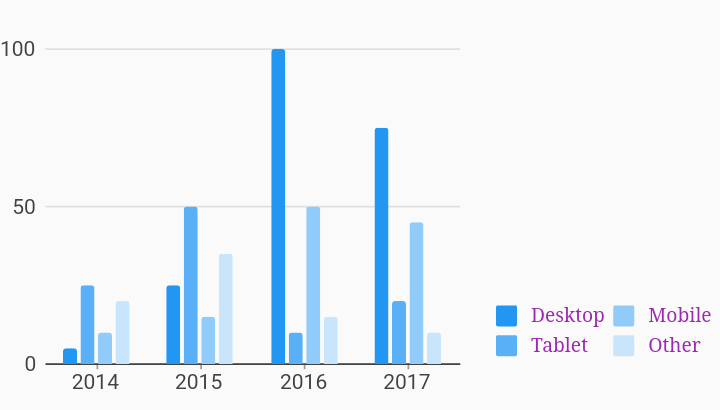community_charts
Legend Options Legends Example

Example:
/// Bar chart with example of a legend with customized position, justification,
/// desired max rows, padding, and entry text styles. These options are shown as
/// an example of how to use the customizations, they do not necessary have to
/// be used together in this way. Choosing [end] as the position does not
/// require the justification to also be [endDrawArea].
import 'package:flutter/material.dart';
import 'package:community_charts_flutter/flutter.dart' as charts;
class LegendOptions extends StatelessWidget {
final List<charts.Series> seriesList;
final bool animate;
LegendOptions(this.seriesList, {this.animate});
factory LegendOptions.withSampleData() {
return new LegendOptions(
_createSampleData(),
// Disable animations for image tests.
animate: false,
);
}
@override
Widget build(BuildContext context) {
return new charts.BarChart(
seriesList,
animate: animate,
barGroupingType: charts.BarGroupingType.grouped,
// Add the legend behavior to the chart to turn on legends.
// This example shows how to change the position and justification of
// the legend, in addition to altering the max rows and padding.
behaviors: [
new charts.SeriesLegend(
// Positions for "start" and "end" will be left and right respectively
// for widgets with a build context that has directionality ltr.
// For rtl, "start" and "end" will be right and left respectively.
// Since this example has directionality of ltr, the legend is
// positioned on the right side of the chart.
position: charts.BehaviorPosition.end,
// For a legend that is positioned on the left or right of the chart,
// setting the justification for [endDrawArea] is aligned to the
// bottom of the chart draw area.
outsideJustification: charts.OutsideJustification.endDrawArea,
// By default, if the position of the chart is on the left or right of
// the chart, [horizontalFirst] is set to false. This means that the
// legend entries will grow as new rows first instead of a new column.
horizontalFirst: false,
// By setting this value to 2, the legend entries will grow up to two
// rows before adding a new column.
desiredMaxRows: 2,
// This defines the padding around each legend entry.
cellPadding: new EdgeInsets.only(right: 4.0, bottom: 4.0),
// Render the legend entry text with custom styles.
entryTextStyle: charts.TextStyleSpec(
color: charts.Color(r: 127, g: 63, b: 191),
fontFamily: 'Georgia',
fontSize: 11),
)
],
);
}
/// Create series list with multiple series
static List<charts.Series<OrdinalSales, String>> _createSampleData() {
final desktopSalesData = [
new OrdinalSales('2014', 5),
new OrdinalSales('2015', 25),
new OrdinalSales('2016', 100),
new OrdinalSales('2017', 75),
];
final tabletSalesData = [
new OrdinalSales('2014', 25),
new OrdinalSales('2015', 50),
new OrdinalSales('2016', 10),
new OrdinalSales('2017', 20),
];
final mobileSalesData = [
new OrdinalSales('2014', 10),
new OrdinalSales('2015', 15),
new OrdinalSales('2016', 50),
new OrdinalSales('2017', 45),
];
final otherSalesData = [
new OrdinalSales('2014', 20),
new OrdinalSales('2015', 35),
new OrdinalSales('2016', 15),
new OrdinalSales('2017', 10),
];
return [
new charts.Series<OrdinalSales, String>(
id: 'Desktop',
domainFn: (OrdinalSales sales, _) => sales.year,
measureFn: (OrdinalSales sales, _) => sales.sales,
data: desktopSalesData,
),
new charts.Series<OrdinalSales, String>(
id: 'Tablet',
domainFn: (OrdinalSales sales, _) => sales.year,
measureFn: (OrdinalSales sales, _) => sales.sales,
data: tabletSalesData,
),
new charts.Series<OrdinalSales, String>(
id: 'Mobile',
domainFn: (OrdinalSales sales, _) => sales.year,
measureFn: (OrdinalSales sales, _) => sales.sales,
data: mobileSalesData,
),
new charts.Series<OrdinalSales, String>(
id: 'Other',
domainFn: (OrdinalSales sales, _) => sales.year,
measureFn: (OrdinalSales sales, _) => sales.sales,
data: otherSalesData,
),
];
}
}
/// Sample ordinal data type.
class OrdinalSales {
final String year;
final int sales;
OrdinalSales(this.year, this.sales);
}